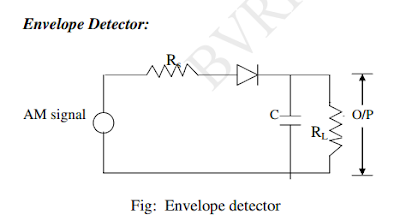Detection of AM Waves
The detection of AM waves is the process of extracting the original modulating signal from the modulated carrier wave. There are several methods for detecting AM waves, but the most common method is envelope detection.
Envelope detection works by rectifying the modulated signal, which produces a waveform that contains only the positive half cycles of the modulated signal. This waveform is then passed through a low-pass filter, which removes the carrier wave and any higher-frequency components, leaving only the original modulating signal.
The basic circuit for envelope detection is shown below:
 |
| Envelope detection circuit |
Envelope detection circuit
In this circuit, the modulated signal is applied to a diode, which rectifies the signal, producing a waveform that contains only the positive half cycles. The output of the diode is then passed through a resistor-capacitor (RC) low-pass filter, which removes the carrier wave and any higher-frequency components. The output of the filter is the original modulating signal.
Another method for detecting AM waves is synchronous detection, which uses a phase-locked loop (PLL) to recover the carrier wave and demodulate the modulated signal. Synchronous detection works by multiplying the modulated signal with a local oscillator signal that is phase-locked to the carrier wave. This produces a difference signal that contains only the original modulating signal.
The basic circuit for synchronous detection is shown below:
 |
| synchronous detection |
Synchronous detection circuit
In this circuit, the modulated signal is multiplied by a local oscillator signal that is phase-locked to the carrier wave. The output of the multiplier is passed through a low-pass filter, which removes the high-frequency components, leaving only the original modulating signal. Synchronous detection is more complex than envelope detection but can provide better performance in some situations.


0 Comments
Do leave your comment